Side Menu:
Fifth Officer Harold Lowe
- Lifeboat 14
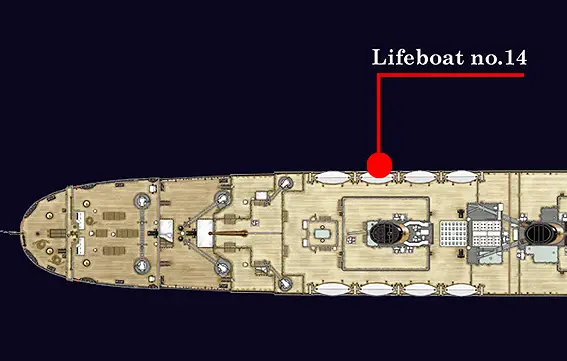
Lowe said that Lightoller "was there a part of the time, and he went away somewhere else. He must have gone to the second boat forward." This meant Lowe was in charge of loading no.14 and put "fifty-eight" in (US Inquiry, Day 5)
Athough it seems Lightoller and Lowe arrived after Wilde had helped load some women and children into lifeboat 14 as there are two witnesses that describe Wilde there. 27-year old Able Seaman, John Poingdestre testified at the British Inquiry about " Mr. Wilde, the Chief Officer" at lifeboat no.14 and that "the boat was filled with women and children also...about 40" but that the "officer" Wilde "did not go with no.14." (British Inquiry)
33-year-old Able Seaman Joseph Scarrott was rescued aboard lifeboat 14 and also testified at the British Inquiry about Wilde being there:
Directly I got to my boat [no.14] I jumped in, saw the plug in, and saw my dropping ladder was ready to be worked at a moment’s notice; and then Mr. Wilde, the Chief Officer, came along and said, “All right; take the women and children,” and we started taking the women and children. There would be 20 women got into the boat, I should say, when some men tried to rush the boats, foreigners they were, because they could not understand the order which I gave them, and I had to use a bit of persuasion... It seemed no sooner the order came along my side of the deck from Mr. Wilde - I heard him personally give that order - we had just started to get people into the lifeboat. We heard that before he got abreast of our boat; we heard it further along the deck, and I continued getting the women in, and when Mr. Wilde came along he gave the order again and assisted me to get the women into the boat. (British Inquiry)
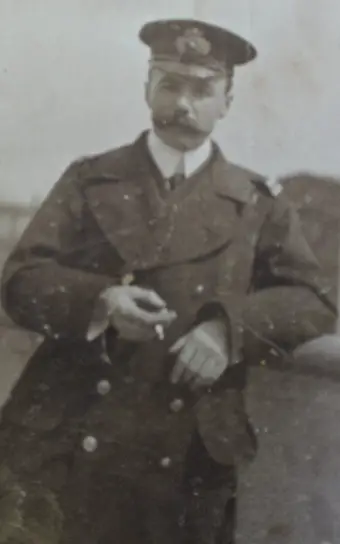
Dr John Edward Simpson gave Lowe an electric torch,
with the words: "Here is something that will be useful
to you". (Click to enlarge)
Lowe described the passengers in lifeboat 14 in some detail: "They were all women and children, bar one passenger, who was an Italian, and he sneaked in, and he was dressed like a woman…He had a shawl over his head, and everything else; and I only found out at the last moment. And there was another passenger that I took for rowing…That was a chap by the name of C. Williams." Lowe had his address: "C. Williams, racket champion of the world," he has here, "No. 2 Drury Road, Harrow-on-the-Hill, Middlesex, England." He also named some other passengers: "The next were Mrs. A. T. Compton, and Miss S. H. Compton, Laurel House, Lakewood, N. J."(US Inquiry, Day 5)
Leading Fireman thomas Threlfall helped Lowe with no.14: "Mr. Lowe, who was off duty at the time, came and lent a hand. No one could have worked harder than he did. I helped him get three lifeboats, with women and children, into the water. The first boat could only be lowered within four feet othe water, so it had to be allowed to fall the remainder of the distance. I was directed to get into the third boat to assist Mr. Lowe in taking charge. There were about fifty women in the boat. Another steward was also put into it. When we were on deck the vessel was dipping at the bow, but there was no perceptible movement downwards. When the lifeboat got on the level of the water, however, it was possible to see the ship sinking inch by inch quite plainly." (Daily Telegraph 29 April 1912, “Titanic – The Homecoming, Tales from the Lapland” by Dr. Paul Lee)
Electric torch and Moody
At some point during the loading of no.14, Dr John Edward Simpson gave Lowe an electric torch, with the words: "Here is something that will be useful to you". The incident was recalled when Lowe met with Dr Simpson's sister "Lizette after the tragedy and recalled meeting Dr Simpson after Titanic’s collision. 'It was dark and he could not see very well when getting a boat lowered. Jack came to him and said "Here is something that will be helpful to you", bringing him an electric torch. He never saw him after that,'”' Lizette wrote to her mother in 1912." (https://maritimebelfast.com/our-heritage/the-dr-simpson-letter/)
As for Lowe taking command of lifeboat no.14, Lowe explained he did not go by anybody's orders, although implies that it was Moody's suggestion: "I saw five boats go away without an officer, and I told Mr. Moody on my own that I had seen five boats go away, and an officer ought to go in one of these boats. I asked him who it was to be - him or I - and he told me, “You go; I will get in another boat.” (British Inquiry)
AB Joseph Scarrott explained the situation:
We were practically full up. I was taking the women in when Mr. Lowe came. There was another officer with him on the boat deck, but I do not know which one that was, and he said to this other officer: “All right, you go in that boat and I will go in this.” That would mean No. 16 boat; she was abaft us, the next boat. Mr. Lowe came in our boat." (British Inquiry)
There is another account which infers that Lowe and Moody may have "tossed" which one would take charge. A Miss E.M German, whose brother knew Lowe personally, wrote in 1955: "Officer Lowe told my brother that he and another officer tossed which of them should take charge of the last lifeboat to leave the ship and Commander Lowe... won." (Courtesy of Paul Lee, https://www.paullee.com/titanic/egerman.php)
Pistol shots
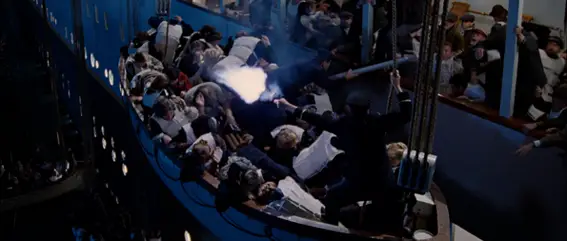
Fifth Officer Lowe (Ioan Gruffudd) firing his 'Browning automatic' as lifeboat no.14 is lowered in a scene from James Cameron's 1997 film "Titanic". (Click image to enlarge)
As the lifeboat was lowered Lowe noticed that it was about 3 feet from off the ship's side and concerned with people jumping into the lifeboat as it was lowered, Lowe fired three pistol shots. He openly referred to it when it was first mentioned at the Senate Inquiry. When Senator Smith asked Lowe "Did you hear any pistol shots?" he replied: "I heard them, and I fired them."(US Inquiry, Day 5)
As I was going down the decks I knew, or I expected every moment, that my boat would double up under my feet. I was quite scared of it, although of course it would not do for me to mention the fact to anybody else. I had overcrowded her, but I knew that I had to take a certain amount of risk. So I thought, "Well, I shall have to see that nobody else gets into the boat or else it will be a case."- I thought if one additional body was to fall into that boat, that slight jerk of the additional weight might part the hooks or carry away something, no one would know what. There were a hundred and one things to carry away. Then, I thought, well, I will keep an eye open. So, as we were coming down the decks, coming down past the open decks, I saw a lot of Italians, Latin people, all along the ship's rails - understand, it was open - and they were all glaring, more or less like wild beasts, ready to spring. That is why I yelled out to look out, and let go, bang, right along the ship's side…As I went down I fired these shots and without intention of hurting anybody and also with the knowledge that I did not hurt anybody…I think I fired three times. There were three decks…I fired horizontally…I had the width of the boat. I was standing up in the after part of her... shot so for them to know that I was fully armed. That is the reason…I put in my pocket and put the safety catch on, because it is a Browning automatic. There were, I suppose, four more remaining... It is an automatic. I think it carries eight."(US Inquiry, Day 5)
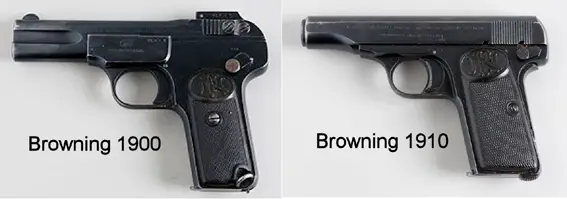
Lowe's "Browning automatic" was likely either a Browning Model 1910 or the 1900.
(Click image to enlarge)
Lowe wrote a similar account in his sworn disposition: "As boat 14, of which I had charge, was being lowered two dark complexioned men tried to jump into the boat. One of them succeeded, and I threw him out; and then, to prevent any repetition of the occurrence, I fired my revolver in the air as I passed each deck."(Harold Lowe's sworn disposition to the British Consulate, 1912, courtesy "On Board RMS Titanic," by George Behe) When pushed on the point of shooting and possibly hitting someone in the dark night, Lowe responded: "Oh, but I could see where I was shooting. A man does not want to shoot over here and look over here [indicating], or to shoot here and look here [indicating], but to look where he shoots. I shot between the boat and the ship's side, so these people would hear and see the discharge."(US Inquiry, Day 5)
He pinpointed the "Italians" as being "below B deck" and "hanging around those open decks; with the windows open, because you do not want better proof than seeing them." (US Inquiry)
Later at the British Inquiry he told the same story: "while I was on the boat deck just as they had started to lower, two men jumped into my boat. I chased one out and to avoid another occurrence of that sort I fired my revolver as I was going down each deck, because the boat would not stand a sudden jerk. She was loaded already I suppose with about 64 people on her, and she would not stand any more…She had too many in her as far as that goes. I was taking risks." (British Inquiry)
As for the identity of the two men trying to jump in: "One was - I do not know whether he was an Italian or what, but he was of the Latin races anyhow?... I do not know who the other was. He managed to get out of the road." (British Inquiry)
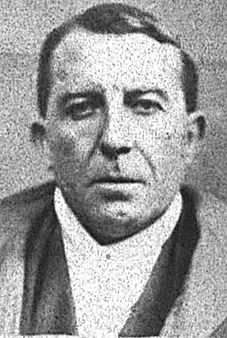
A. B. Joseph Scarrott said Lowe
pulled out his revolver and he fired
two shots between the ship and
the boat’s side
There are several eyewitness accounts to corroborate Lowe's testimony, notably from AB Scarrott who was in lifeboat no.14 and explains how the situation arose:
I told him [Lowe] that I had had a bit of trouble through the rushing business, and he said, “All right.” He pulled out his revolver and he fired two shots between the ship and the boat’s side, and issued a warning to the remainder of the men that were about there. He told them that if there was any more rushing he would use it. When he fired the two shots he fired them into the water. He asked me, “How many got into the boat?” I told him as near as I could count that that was the number, and he said to me, “Do you think the boat will stand it?” I said, “Yes, she is hanging all right.” “All right,” he said, “Lower away 14.”" (British Inquiry)
Leading fireman Threlfall described Lowe as "a gentleman and a Britisher" and mentioned that he got into No.14 boat, the last but one on the port side to go... Mr. Lowe was in command, and as we put off he took a revolver from his pocket and said: 'We want no dirty work here. I'll shoot two at a time.'" (Daily Mail 29 April 1912, “Titanic – The Homecoming, Tales from the Lapland” by Dr. Paul Lee)
George Crow, a saloon steward also in lifeboat no.14 also mentioned the pistol shots:
"There were various men passengers, probably Italians or some foreign nationality other than English or American, who attempted to rush the boats. The officers threatened to shoot any man who put his foot into the boat. He fired the revolver, but either downward or upward, not shooting at any of the passengers at all and not injuring anybody. He fired perfectly clear, upward or downward… No disorder. Well, one woman was crying, but that was all; no panic or anything in the boat.. (US Inquiry)
Frederick Clench, in neighbouring lifeboat no.12, also noted the pistol shots at no.14:
Mr. CLENCH. Mr. Lowe was in No. 14 boat, and he sings out, "Anybody attempting to get into these boats while we are lowering them, I will shoot them," and he shot three shots.
Senator BOURNE. Did he shoot anybody?
Mr. CLENCH. He shot straight down in the water.
Senator BOURNE. Did not fire at anybody?
Mr. CLENCH. No, sir; just shot to frighten the people.(US Inquiry)
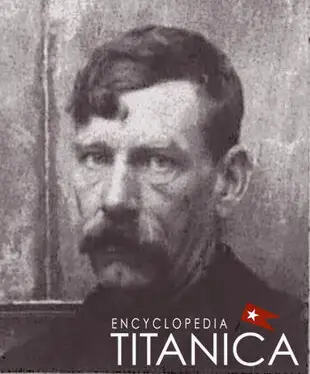
AB Frederick Clench testified that Lowe said he
would shoot anyone attemping to get into the
lifeboat. (Image dated 1919, Encyclopedia
Titanica)
22 year old second class passenger Selena Cook (nee Rogers) who boarded lifeboat 14 later said: "As we left the Titanic several men were on the point of jumping into our boat, already overcrowded. They were stopped by Officer Louve [sic] drawing a revolver." (Worcester Evening Gazette, 19 April 1912)
First class passenger Daisy Minahan also described the event:
"When the lifeboat was filled there were no seamen to man it. The officer in command of No. 14 called for volunteers in the crowd who could row. Six men offered to go. At times when we were being lowered we were at an angle of 45 degrees and expected to be thrown into the sea. As we reached the level of each deck men jumped into the boat until the officer threatened to shoot the next man who jumped. We landed in the sea and rowed to a safe distance from the sinking ship." (US Inquiry)
Second class passenger Esther Hart, along with her daughter Eva, remembered Lowe saying he would shoot any man who tried to enter the boat "like a dog.":
"Eva was thrown in first, and I followed her. Just then, a man who had previously tried to get in succeeded in doing so, but was ordered out, and the officer fired his revolver into the air to let everyone see it was loaded, and shouted out, 'Stand back! I say, stand back! The next man who puts his foot in this boat, I will shoot him down like a dog.' Ben, who had been doing what he could to help the women and children, said quietly, 'I'm not going in, but for God's sake look after my wife and child.' And little Eva called out to the officer with the revolver, 'Don't shoot my daddy. You shan't shoot my daddy.' What an experience for a little child to go through! At the age of seven to have passed through the valley of the shadow of death. I wonder if she will ever forget it? I know I shan't, if I live for a hundred years." (Ilford Graphic 12 May 1912)
Charlotte Collyer, also from second class, described even more dramatic accounts of violence, during the loading of lifeboat 14:
The boat was practically full, and no more women were anywhere near it when Fifth Officer Lowe jumped in and ordered it lowered. The sailors on deck had started to obey him when a very sad thing happened. A young lad, hardly more than a school boy, a pink-cheeked lad almost small enough to be counted as a child, was standing close to the rail. He had made no attempt to force his way into the boat, though his eyes had been fixed piteously on the officer. Now, when he realised that he was really to be left behind, his courage failed him. With a cry, he climbed upon the rail and leaped down into the boat. He fell among us women and crawled under a seat. I and another woman covered him up with our skirts.
We wanted to give the poor lad a chance, but the officer dragged him to his feet and ordered him back upon the ship.
He begged for his life. I remember him saying that he would not take up much room, but the officer drew his revolver and thrust it into his face. I'll give you just ten seconds to get back on to that ship before I blow your brains out!' he shouted.
The lad only begged the harder, and I thought I should see him shot as he stood.
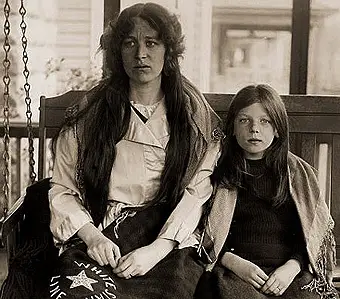
Charlotte Collyer and her daughter, Marjorie, aged 8.
Both told dramatic stories of violence during the loading
of lifeboat no.14.
But the officer suddenly changed his tone. He lowered his revolver and looked the boy squarely in the eyes. 'For God's sake, be a man!' he said gently. 'We've got women and children to save. We must stop at the decks lower down and take on women and children.'
The little lad turned round and climbed back over the rail without a word. He look a few uncertain steps, then lay face down upon the deck, his head beside a coil of rope. He was not saved.
All the women about me were sobbing, and I saw my little Marjorie take the officer's hand. 'Oh, Mr Man, don't shoot, please don't shoot the poor man!' she was saying, and he spared the time to shake his head and smile.
He screamed another order for the boat to be lowered, but just as we were getting away a steerage passenger, an Italian, I think, came running the whole length of the deck and hurled himself into the boat. He fell upon a young child, I found out afterward, and injured her internally. The officer seized him by the collar and by sheer brute strength pushed him back on to the Titanic. As we shot down toward the sea, I caught a last glimpse of this coward. He was in the hands of about a dozen men of the second cabin. They were driving their fists into his face, and he was bleeding from the nose and mouth.
(Washington-Post Semi-Monthly Magazine 26 May 1912 courtesy "On Board RMS Titanic," by George Behe)
Charlotte's daughter Marjorie, aged 8, also gave an account that in some way verifies her mother's version: "There was one officer in our boat who had a pistol. Some men jumped into our boat on top of the women and crushed them and the officer said that if they didn't stop he would shoot. Another man jumped and he shot him." (Leatherhead Advertiser, Epsom District Times and County Post, 18 May 1912.)
Not all accounts mentioned the use of Lowe's revolver. One unidentified passenger in lifeboat 14, "a young English woman, who requested that her name be omitted" said that "before the lifeboat was launched, he passed along the port deck of the steamer, commanding the people not to jump in the boats and otherwise restraining them from swamping the craft." (The Globe, 18th April 1912)
Lifeboat 14 - Into the water - "Slipped her"
As inferred in Daisy Minahan's report of the steep ""45 degree" angle, Saloon Steward George Crowe also reported an issue upon lifeboat 14 reaching the water:
That was his [Lowe's] boat; yes, sir. After getting the women and children in, we lowered down within 4 or 5 feet of the water and found the block and tackle had gotten twisted in some way, causing us to have to cut the ropes to allow the boat to get into the water…I stood by the lever. The lever releases the blocks from the hooks in the boat, and he told me to wait, to get away and cut the line to raise the lever, thereby causing the hooks to open and allow the boat to drop in the water. After getting into the water we pushed out to the other boats. Fifth Officer Lowe suggested standing by in case of any necessity for us to do so. (US Inquiry)
Lowe explained the issue and his resolution which he called "slipping":
"Something got wrong and I slipped her…I should say I dropped her about 5 feet…That was because I was not going to wait and chance being dipped down by the stern by anybody on top, so I thought it was best for me to drop, and know what I was doing…you must understand that the lowering away was being carried out on deck, and I must have been about 64 feet below that deck, and I could not see it..I looked up and I could not see anything." (British Inquiry)
The process of slipping caused a man overboard according to a report by an unnamed steward: "Another version was given by a second class steward of the conduct of Mr. Lowe, the fifth officer … The steward was called upon to assist, after which he was lowered into a boat with Mr. Lowe in charge. When the boat was within four feet of the water there was not sufficient rope to lower her further, so that she had to be dropped into the water. The steward was jerked overboard, picked up by another boat, and transferred to his original position." (Western Daily Mercury 29 April 1912, “Titanic – The Homecoming, Tales from the Lapland” by Dr. Paul Lee)
Second class passenger Esther Hart quoted the Fifth Officer giving orders to the women not to cry:
The officer in charge of our boat was standing on that raised part of it right at the end. We were all women and children aboard and we were all crying and sobbing; and the officer said, not roughly, but I think with a kindly desire to keep our minds off the terrible time we had gone through. 'Don't cry, please don't cry. You'll have something else to do than cry; some of you will have to handle the oars. For God's sake stop crying. If I had not the responsibility of looking after you I would put a bullet through my brain.' So we got away from the ship for a safe distance, for there was no doubt now about her sinking. (Ilford Graphic 12 May 1912)
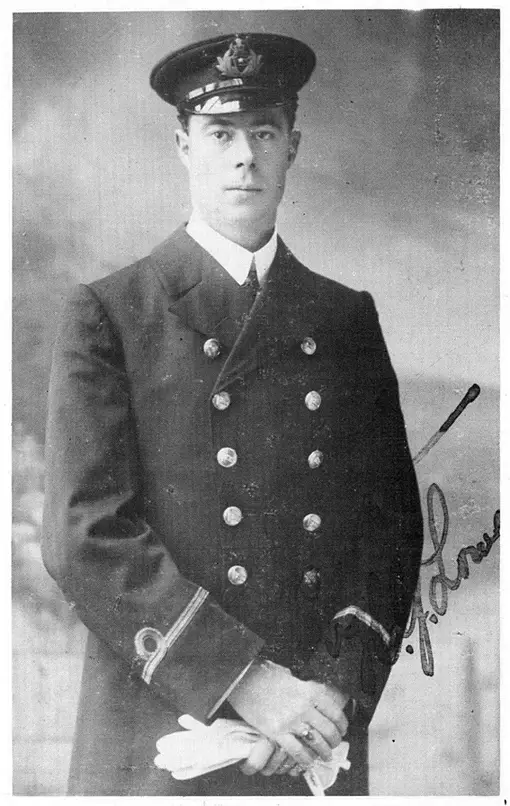
A postcard of Lowe in his White Star officers uniform.
(Credit: Cavalier Postcards, courtesy of Conner Nelson)
Lay off
Lowe had lifeboat 14 rowed, as he described, so as to "lay off from the Titanic, as near as I could roughly estimate, about 150 yards, because I wanted to be close enough in order to pick up anybody that came by." (US Inquiry)
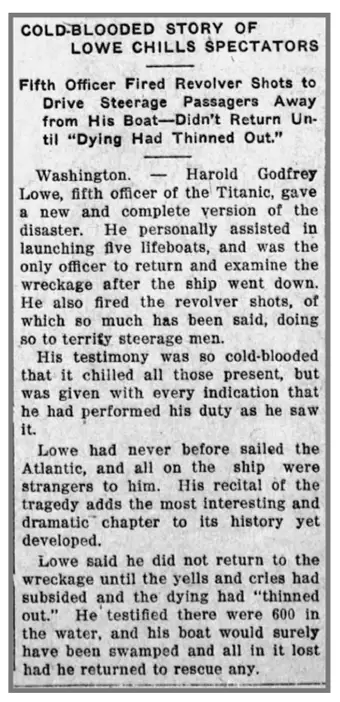
Lowe's firing of his gun and waiting until the 'dying
had thinned out' made for dramatic headlines, such as
this in the article in the Essex County Herald (Island
Pond, Vermont) 3 May 1912,
AB Scarrott was one of the men manning the oars and he described that he was on the "after oar on the port side of the boat along with a fireman, rowing to avoid the suction:
"We just rowed clear of the ship. I suppose Mr. Lowe used his discretion to get clear of the suction which was likely to take place, and we saw four other boats then. Sixteen was the nearest boat. She had just got clear a little previous to us…I was pulling the after-oar on the port side of the boat, and on my left was a fireman; but as regards the other two that were further forward on the boat, I cannot say what they were as regards their rating…There is a correction there, my Lord. There was one man in that boat that we had been under the impression - when I say “we,” I mean the watch of sailors - that he was a sailorman. That man was not a sailor at all…window-cleaner; he was supposed to be in the ship as a window-cleaner." (British Inquiry)
Scarrott adds that at "150 yards" from Titanic they "lay there with the remainder of the other boats - with the four other boats that we saw when we got clear of the ship…Mr. Lowe asked them who was in charge of the boats, what officers were there, and we got a reply from each boat individually to say they had no officer in the boat. He said: “All right consider the whole of you are under my orders; remain with me,” (British Inquiry)
Bathroom steward Frank Morris, in lifeboat no.14, estimates they were quarter of a mile away: "He [Lowe] told us to pull away from there, and not to pull too far… About a quarter of a mile on a rough estimation." (British Inquiry)
Saloon steward Crowe stated that Lowe wanted to remain nearby but also mentions a leak in the lifeboat:
His [Lowe's] idea was to stand by in case of an emergency; that is anybody coming over the sides, with the idea of picking them up. I might state in between there the boat had sprung a leak and taken in water, probably 8 inches of water. That is, when the boat was released and fell, I think she must have sprung a leak….when we transferred our people was when we discovered the amount of water that was in the boat, because just prior to getting to the other boat a lady stated that there was some water coming over her ankles, and two men and this lady - I believe the lady - assisted in bailing it out with bails that were kept in the boat for that purpose. (US Inquiry)
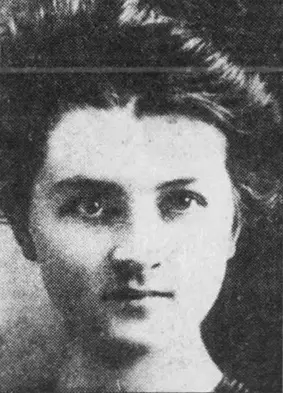
Passenger Daisy Minahan claims that Lowe said:
"I think the best thing for you women to do is
to take a nap.".(Encyclopedia Titanica)
Passenger Daisy Minahan also mentions there was no light, bread or water in the boat:
"The officer counted our number and found us to be 48. The officer commanded everyone to feel in the bottom of the boat for a light. We found none. Nor was there bread or water in the boat. The officer whose name I learned afterwards to be Lowe, was continually making remarks such as, "A good song to sing would be, Throw Out the Life Line," and "I think the best thing for you women to do is to take a nap." (US Inquiry)
Lowe said at the Senate Inquiry that he saw the Titanic sink. "She went down head first and inclined at an angle. That is, when she took her final plunge she was inclined at an angle of about 75º." Lowe did not see people on the decks however "It was pretty well dark" and "I heard explosions, yes; I should say about four." (Senate Inquiry). He also wrote: "The ship by this time [was] settling down rapidly by the head, and sank in about 20 minutes. The lights were burning up to 5 minutes before the stern disappeared. I did not hear anything that I should call explosions. A kind of distant smothered rumblings. I thought at the time it was produced by the sinking of the ship. (Harold Lowe's sworn disposition to the British Consulate, 1912, courtesy "On Board RMS Titanic," by George Behe) Several eyewitnesses in lifeboat no.14 clearly saw the ship split in two, but Lowe never mentioned this in his accounts.
Threlfall indicates that Lowe may have been aware of the Titanic splitting in two, as the leading fireman saw it clearly: "When the boilers broke out of the ship, it was dreadful. Mr. Lowe, the fifth officer, was in command of my boat, and I heard him say: 'Thank God! Perhaps she will float now with all that weight out of her.' "Then she broke again, and we knew she must go down." (Daily Mirror 29 April 1912, “Titanic – The Homecoming, Tales from the Lapland” by Dr. Paul Lee)
Flotilla and Redistribution
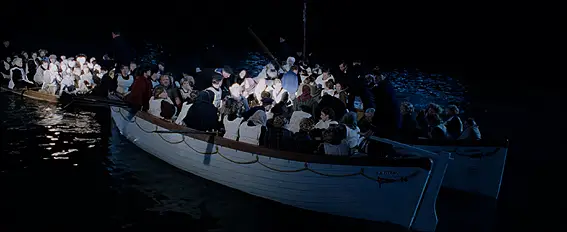
Fifth Officer Lowe (Ioan Gruffudd) bringing one lifeboat (possibly 4, 10 or 12) together with 14 along with collapsible D, as portrayed in James Cameron's 1997 film "Titanic". (Click image to enlarge)
At some point likely prior to the Titanic sinking, Lowe had met up with lifeboats, 4, 10, 12 and collapsible D, forming them into a flotilla of sorts in which he redistributed the numbers so as to free up lifeboat 14 for a return for more survivors. Lowe explained the process:
I was in No. 14. Then I had 10, I had 12, and I had another collapsible, and one other boat the number of which I do not know. I herded them together and roped them - made them all tie up - and of course I had to wait until the yells and shrieks had subsided - for the people to thin out - and then I deemed it safe for me to go amongst the wreckage. So I transferred all my passengers - somewhere about 53 passengers - from my boat, and I equally distributed them between my other four boats. Then I asked for volunteers to go with me to the wreck. (US Inquiry)
At the British Inquiry Lowe also said: "I tied them together in a string, and made them step their masts." (British Inquiry)
Crowe in no.14 confirmed the process: "When we got out a distance the officer asked me how many people we had in the boat, thinking the other boats had not got their number, and it was his idea to put our people into their boats and return back." (US Inquiry)
It was not just about the passengers - Lowe also redistributed the crew, according to an unidentifed woman occupant: "He collected the other boats together. In some cases the boats were short of adequate crew, and he directed an exchange by which each was adequately manned. He threw lines connecting the boats together, two by two, and all thus moved together." (The Globe, 18th April 1912)
The idea of joining boats together was not something that Lowe concocted once at sea; the idea had been already touted while they were on the boat deck, according to the testimony of Frederick Clench, in lifeboat number 12, who told the Senate Inquiry: "We had instructions when we went down that we were to keep our eye on No. 14 boat, where Mr. Lowe, the fifth officer, was, and keep all together as much as we could, so that we would not get drifted away from one another." (Senate Inquir )
Esther Hart remembered what Lowe shouted: "Our officer was busy shouting out till he was hoarse, 'Let all the boats keep as near together as possible. That's our only chance of being picked up. If we separate we are lost. Keep together.' An inky blackness now settled over us, and not a soul in our boat had a match; but the officer found in his pockets an electric torch, which he kept flashing, shouting out all the time, 'Keep together - it's our only chance.' The duty that the officer allotted to me was to bale the water out of the boat." (Ilford Graphic 12 May 1912)
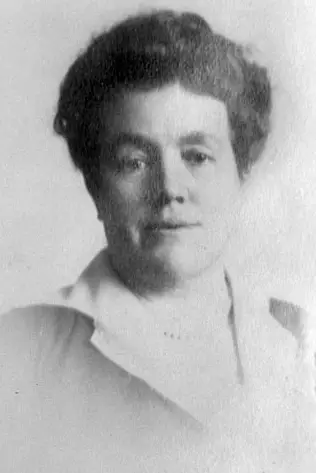
Emily Ryerson, in boat no.4 said Lowe used his
whistle to bring the boats together.
48-year-old first class passenger Emily Ryerson, in boat no.4, described Lowe using his whistle to bring the boats together: "After the Titanic sank we saw no lights, and no one seemed to know what direction to take. Lowe, the officer in charge of the boat, had called out earlier for all to tie together, so we now heard his whistle, and as soon as we could make out the other boats in the dark, five of us were tied together, and we drifted about without rowing, as the sea was calm, waiting for the dawn." (US Inquiry)
Arthur John Bright was a quartermaster in collapsible D who also witnessed the process:
I did not count them then; but after we got away there was Mr. Lowe, the fourth officer, came alongside of us in another boat, and told us stick together, and then he asked the number in the boat, and there was a steward by the name of Hardy counted them and told him, and then they put ten or a dozen men into our boat because it was not filled up.…..There were five boats, all close up together; and where boats were overloaded he was taking the people out and putting them into the boats that had room to carry them.
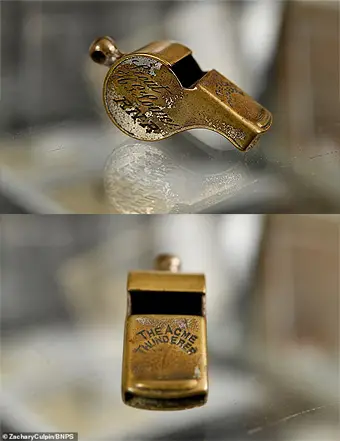
Harold Lowe's RNR whistle on display. (Click to enlarge)
Scarrott mentioned another reason for the boats being tied up -that they would be easier to spot:
Mr. Lowe ordered four of the boats to tie together by the painters. He told the men that were in charge of them, the seamen there, what the object was. He said, 'If you are tied together and keep all together, if there is any passing steamer they will see a large object like that on the water quicker than they would a small one.' (British Inquiry)
John Hardy, chief steward, second class, remembered Lowe saying they would be "better seen":
"Finally we all got together, about seven boats of us, and I remember quite distinctly Boatswain Lowe telling us to tie up to each other, as we would be better seen and could keep better together. Then Officer Lowe, having a full complement of passengers in his boat, distributed among us what he had, our boat taking 10. We had 25 already, and that number made 35." (US Inquiry, Day 5)
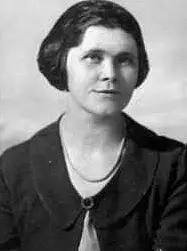
Second class passenger Selena
Cook thought lifeboat 14 was in
danger of being swamped.
(Encyclopedia Titanica)
22 year old second class passenger Selena Cook in no.14 mentioned another possible reason: "Crowded to more than its capacity, the boat was endangered of being swamped when Fourth Officer Louve [sic], who had it in charge, succeeded in transferring some of his passengers to one of the other boats... After taking us out of the range of the Titanic's suction, he transferred us to other boats that had not been completely filled and went back for more from the sinking ship. Too much praise cannot be given the officer for his work. We were in the boat for three or four hours listening to the cries and groans of those who had jumped overboard and were not rescued, and those in other boats." (Worcester Evening Gazette, 19 April 1912)
Frank Evans, an AB in boat number 10, remembered Lowe asking for seaman to return:
He [Lowe] came over in No. 14 boat, and he says, "Are there any seamen there?" We said, "Yes, sir." He said, "All right; you will have to distribute these passengers among these boats. Tie them all together and come into my boat," he said, "to go over into the wreckage and pick up anyone that is alive there."
Bathroom steward Frank Morris, in lifeboat no.14 seemed to confirm that the flotilla was formed before the Titanic sank, although others indicate it happened afterward (perhaps it was over a long period of time):
When we pulled away from her, Mr. Lowe asked how many were in the boat, and he said we had not enough, and he said we would have to pull back and see who we could pick up… As we were rowing round in the vicinity of the “Titanic” we came upon four lifeboats, and Officer Lowe asked who was in charge, if they had an officer, and they said “No”; and he said, “Consider yourself under my charge.” Then we put our women and children into their boats, and then he asked if our sail was all right, and we put up the mast of the sail because he said it might be useful in the night. After the boat was down he said we would have to do our best to try and pick up as many as we could. (British Inquiry)
Fireman Threlfall recalled: "Then he [Lowe] called to several other boats close by, 'Throw out your painters,' and we linked them all up. Mr. Lowe passed about fifty women and children from his boat, and said, 'We will go for the wreckage,' to which other people were clinging. From the wreckage we picked up four men." (Daily Mail 29 April 1912, “Titanic – The Homecoming, Tales from the Lapland” by Dr. Paul Lee)
Before leaving to find survivors Lowe left instructions. According to Frederick Clench in lifeboat no.12 Lowe told them "to lie on our oars and keep together until he came back to us." (US Inquiry)
"Italian"... shawl over his head
It was during this redistribution of passengers that Lowe claims he discovered an "Italian" man dressed as a woman with a "shawl over his head" who he described as "not worthy of being handled better."
It was at this time that I found this Italian. He came aft, and he had a shawl over his head and I suppose he had skirts. Anyhow, I pulled this shawl off his face and saw he was a man. He was in a great hurry to get into the other boat, and I caught hold of him and pitched him in….because he was not worthy of being handled better…[into] in the fore part of the lifeboat in which I transferred my passengers…I did not say a word to him.(US Inquiry, Day 5)
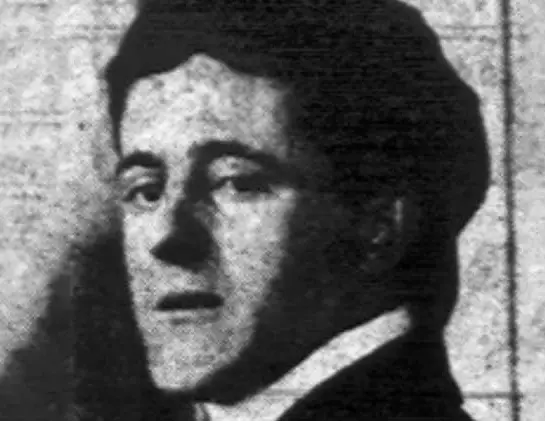
24-year old third class Irishman, Edward Ryan. Is this the man who dressed as woman and was discoverd by Fifth Officer Lowe?
As for the identity of the "Italian" he was possibly an Irishman named Edward Ryan, according to author Tim Maltin:
This was probably Third Class passenger Edward Ryan, who freely admitted in a letter to his parents that he had put a towel over his head in order to pass as a woman and enter a lifeboat. He was Irish, but Lowe may not have realised this in the dark, and probably allowed his prejudices about foreigners in general and Italians in particular to colour his judgment of the man’s true nationality. (https://timmaltin.com/2019/04/20/titanic-escape-pretending-to-be-woman/)
24 year old Irishman Edward Ryan wrote in a letter to his parentes dated 6 May 1912:
"I stood on the Titanic and kept cool, although she was sinking fast. She had gone down about forty feet by now. The last boat was about being rowed away when I thought in a second if I could only pass out [i.e. get into the boat] I'd be all right. I had a towel round my neck. I just threw this over my head and left it hang in the back. I wore my waterproof overcoat. I then walked very stiff past the officers, who had declared they'd shoot the first man that dare pass out. They didn't notice me. They thought I was a woman. I grasped a girl who was standing by in despair, and jumped with her thirty feet into the boat." (Encyclopedia Titanica)

Or was it third class Irish passenger Daniel
Buckley? (Encyclopedia Titanica)
Another possibility is 21 year old Third Class passenger Daniel Buckley, who described a woman passenger who had "thrown her shawl over me, and she told me to stay in there."
When the sixth lifeboat was prepared, there was a big crowd of men standing on the deck. And they all jumped in. So I said I would take my chance with them....Passengers and sailors and firemen mixed. There were no ladies there at the same time. When they jumped, I said I would go too. I went into the boat. Then two officers came along and said all of the men could come out. And they brought a lot of steerage passengers with them; and they were mixed, every way, ladies and gentlemen. And they said all the men could get out and let the ladies in. But six men were left in the boat. I think they were firemen and sailors.
I was crying. There was a woman in the boat, and she had thrown her shawl over me, and she told me to stay in there. I believe she was Mrs. Astor. Then they did not see me, and the boat was lowered down into the water, and we rowed away out from the steamer.
The men that were in the boat at first fought, and would not get out, but the officers drew their revolvers, and fired shots over our heads, and then the men got out. When the boat was ready, we were lowered down into the water and rowed away out from the steamer. We were only about 15 minutes out when she sank.(US Inquiry, Day 13)
Although the exact lifeboat Buckley was saved in is uncertain, he does mention officers with revolvers who "fired shots over our heads" which tallies with Lowe's actions at no.14. Mrs Astor was not in 14, but left in boat 4, so it was likely another woman passenger.
See also...
Next... The Return